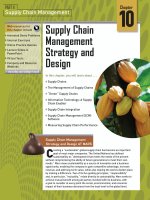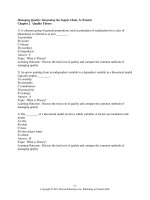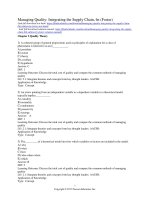Lecture Operations management: Creating value along the supply chain (Canadian edition) - Chapter 7S
Bạn đang xem bản rút gọn của tài liệu. Xem và tải ngay bản đầy đủ của tài liệu tại đây (369.72 KB, 34 trang )
OPERATIONS MANAGEMENT:
Creating Value Along the Supply Chain,
Canadian Edition
Robert S. Russell, Bernard W. Taylor III, Ignacio Castillo, Navneet Vidyarthi
CHAPTER 7 Supplement
Facility Location Models
Learning Objectives
Explain the major categories of facilities and the
factors important in facility location.
Explain the general considerations of the facility site
selection process for services and manufacturing
facilities.
Discuss the factors a company should consider
when selecting facility site and explain how
geographic information systems (GIS) can be used
as a site selection tool.
Use three quantitative tools for facility site selection.
Copyright 2014 John Wiley &
Supplement 7-2
Lecture Outline
Types of Facilities
Site Selection: Where to Locate
Site Selection: Factors to Consider
Location Analysis Techniques
Copyright 2014 John Wiley &
Supplement 7-3
Types of Facilities
Heavy-manufacturing facilities
large, require a lot of space, and are
expensive
Light-industry facilities
smaller, cleaner plants and usually less
costly
Retail and service facilities
smallest and least costly
Copyright 2014 John Wiley &
Supplement 7-4
Factors in Heavy
Manufacturing Location
Construction costs
Land costs
Raw material & finished goods shipment
modes
Proximity to raw materials
Utilities
Means of waste disposal
Labour availability
Copyright 2014 John Wiley &
Supplement 7-5
Factors in Light Industry Location
Land costs
Transportation costs
Proximity to markets
depending on delivery requirements
including frequency of delivery required by
customer
Copyright 2014 John Wiley &
Supplement 7-6
Factors in Retail Location
Proximity to customers
Location is everything
Copyright 2014 John Wiley &
Supplement 7-7
Site Selection: Where to Locate
Infrequent but important
being “in the right place at
the right time”
Must consider other
factors, especially
financial considerations
Location decisions made
more often for service
operations than
manufacturing facilities
Location criteria for
service
access to customers
Location criteria for
manufacturing facility
nature of labor force
labour costs
proximity to suppliers
and markets
distribution and
transportation costs
energy availability and
cost
community infrastructure
quality of life in
Copyright 2014 John Wiley &
Supplement 7-8
Global Supply Chain Factors
Government stability
Government
Climate
Number & proximity of
regulations
suppliers
Political & economic
Transportation &
systems
distribution system
Economic stability &
Labour cost &
growth
education
Exchange rates
Available technology
Culture
Commercial travel
Export/import
Technical expertise
regulations, duties
& 2014 John
Cross-border
trade 7-9
Copyright
Wiley &
Supplement
Regional and Community Location
Factors in Canada
Labour (availability,
Modes and quality of
education, cost, and
unions)
Proximity of customers
Number of customers
Construction/leasing
costs
Land cost
transportation
Transportation costs
Community
government Local
business regulations
Government services
(e.g., Chamber of
Commerce)
Copyright 2014 John Wiley &
Supplement 7-10
Regional and Community Location
Factors in Canada
Business climate
Community services
Incentive packages
Government
regulations
Environmental regs.
Raw material
availability
Commercial travel
Climate
Infrastructure (road &
utilities)
Quality of life
Taxes
Availability of sites
Financial services
Community
inducements
Proximity of suppliers
Education system
Copyright 2014 John Wiley &
Supplement 7-11
Location Incentives
Tax credits
Relaxed government regulation
Job training
Infrastructure improvement
Money
Copyright 2014 John Wiley &
Supplement 7-12
Geographic Information Systems (GIS)
Computerized system for storing, managing,
creating, analyzing, integrating, and digitally
displaying geographic, i.e., spatial, data
Specifically used for site selection
Enables users to integrate large quantities of
information about potential sites and analyze these
data with many different, powerful analytical tools
Copyright 2014 John Wiley &
Supplement 7-13
GIS Diagram
Copyright 2014 John Wiley &
Supplement 7-14
Location Analysis Techniques
Location factor rating
Centre-of-gravity
Load-distance
Copyright 2014 John Wiley &
Supplement 7-15
Location Factor Rating
Identify important factors
Weight factors (0.00 - 1.00)
Subjectively score each factor (0 - 100)
Sum weighted scores
Copyright 2014 John Wiley &
Supplement 7-16
Location Factor Rating
SCORES (0 TO 100)
LOCATION FACTOR
Labor pool and climate
Proximity to suppliers
Wage rates
Community environment
Proximity to customers
Shipping modes
Air service
WEIGHT
Site 1
Site 2
Site 3
.30
.20
.15
.15
.10
.05
.05
80
100
60
75
65
85
50
65
91
95
80
90
92
65
90
75
72
80
95
65
90
Weighted Score for “Labor pool and climate” for
Site 1 = (0.30)(80) = 24
Copyright 2014 John Wiley &
Supplement 7-17
Location Factor Rating
WEIGHTED SCORES
Site 1
Site 2
Site 3
24.00
20.00
9.00
11.25
6.50
4.25
2.50
77.50
19.50
18.20
14.25
12.00
9.00
4.60
3.25
80.80
27.00
15.00
10.80
12.00
9.50
3.25
4.50
82.05
Copyright 2014 John Wiley &
Site 3 has the highest
factor rating
Supplement 7-18
Location Factor Rating With Excel
Copyright 2014 John Wiley &
Supplement 7-19
Location Factor Rating With OM Tools
Copyright 2014 John Wiley &
Supplement 7-20
Centre-of-Gravity Technique
Locate facility at centre of movement in geographic
area
Based on weight and distance traveled;
establishes grid-map of area
Identify coordinates and weights shipped for each
location
Copyright 2014 John Wiley &
Supplement 7-21
Grid-Map Coordinates
y
n
n
xiWi
i=1
2 (x2, y2), W2
y2
yiWi
x=
i=1
y=
n
n
Wi
y1
i=1
1 (x1, y1), W1
Wi
i=1
where,
3 (x3, y3), W3
y3
x1
x2
x3
x, y = coordinates of new
facility at centre of gravity
xi, yi = coordinates of existing
facility i
Wi = annual weight shipped
from facility i
x
Copyright 2014 John Wiley &
Supplement 7-22
Centre-of-Gravity Technique
y
700
600
Miles
500
(135)
B
(105)
400
300
200
x
y
W
C
A
200
200
75
B
100
500
105
C
250
600
135
D
500
300
60
D
(60)
A
(75)
100
0
100 200 300 400 500 600 700 x
Miles
Copyright 2014 John Wiley &
Supplement 7-23
Centre-of-Gravity Technique
n
xiWi
x=
i=1
n
(200)(75) + (100)(105) + (250)(135) + (500)(60)
=
= 238
75 + 105 + 135 + 60
Wi
i=1
n
yiWi
y=
i=1
=
n
(200)(75) + (500)(105) + (600)(135) + (300)(60)
= 444
75 + 105 + 135 + 60
Wi
i=1
Copyright 2014 John Wiley &
Supplement 7-24
Centre-of-Gravity Technique
y
700
600
Miles
500
400
300
200
A
x
200
C
(135)
y
200
B
W
75
(105)
Centre of gravity (238,
444) D
(60)
A
B
100
500
105
C
250
600
135
D
500
300
60
(75)
100
0
100 200 300 400 500 600 700 x
Miles
Copyright 2014 John Wiley &
Supplement 7-25









